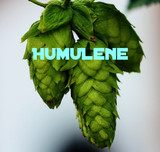Alpha-Humulene makes up about 40% of the essential oil of hops and is a common cannabis terpene. Cannabis (including CBD hemp flower) is actually closely related to hops so it is natural for them to share this terpene. Humulene is the source of the 'hoppy' flavors of beer. Outside of hops and cannabis, it can be found in plants like sage and ginseng. It is also called alpha-caryophyllene and is really more of a variety of caryophyllene than a separate type of terpene.
 The Humulene Molecule
The Humulene MoleculeTable Of Contents
Beta-Caryophyllene vs Alpha-Humulene
Humulene is really just another configuration of the terpene beta-caryophyllene [2]. However, this slight difference in shape means that humulene does not have the ability to interact with CB2 receptors like beta-caryophyllene does.
Humulene, formerly known as a-caryophyllene, is described as one of the core cannabis terpenes, along with myrcene, terpinolene, limonene, pinene, and geraniol. ...its aroma is earthy and woody, with spicy, herbal notes. In cannabis, it is found most often in sativa strains.
Tomko, A. M., Whynot, E. G., Ellis, L. D., & Dupré, D. J. (2020). Anti-Cancer Potential of Cannabinoids, Terpenes, and Flavonoids Present in Cannabis.
Humulene Effects and Benefits
Ant-Inflammatory Properties
Cordia verbenacea (aka Erva Baleeira, “Black Sage”) essential oil contains humulene and trans-caryophyllene. Research by Fernandes, et al. evaluated the anti-inflammatory properties of these caryophyllene variants. They found that when taken in an oral preparation (in mice), the terpenes helped inhibit inflammatory factors (cell secretions) such as TNF-a, PGE-2, and IL-1-beta (among others). The powerful anti-inflammatory ability of humulene work in topical and systematic applications [2]. It also has analgesic properties that dull the sensation of pain.
Anti-Cancer Properties
Fernandes, et al, 20017, summarizes the specific anti-cancer properties of humulene that have been observed in animal/human studies ('in vivo'), and in studies of cells in petri dishes ('in vitro'). In vivo, humuleme has been observed to inhibit cell proliferation and increase a type of 'programmed cell death' called 'apoptosis.'
In vitro, humulene was observed to enhance the effects of the anti-cancer drugs 5-fluoruracil, oxaliplatin, and doxorubicin [1]. In these in vitro lab studies, humulene also increased reactive oxygen species (ROS) and cytotoxic (cell-killing) effects. It also inhibited an insulin production-related signal pathway called 'Akt' which promotes apoptosis [1, 3].
'Antineoplastic effects' inhibit or stop the formation of tumors ('neoplasms'). Humulene's ability to increase ROS production is said to result in this effect [1, 2]. It is also said to promote wound healing by increasing the production of the compound interleukin-6 [1].
High Humulene Cannabis Strains
Humulene is part of most strain's terpene profile. However, if you are looking for a cannabis strain with especially high humulene content, here are some to consider.
- Girl Scout Cookies Hemp (GSC CBD Vape)
- Headband
- White Widow
- Pink Kush
- Bubba Kush (Bubba Kush Hemp)
- Super Lemon Haze
- Sour Diesel (Sour Diesel Hemp)
- Skywalker OG (Skywalker Hemp)
Concluding Thoughts
Humulene is yet another example of how beneficial and important terpenes are. The terpene profile of a cannabis strain is a lot like its finger print. It is one of the features that make genetic varieties so unique. Likewise, terpenes are very much a part of the cannabis experience and work in harmony with cannabinoids.
When it comes to indica vs sativa, those terms really do not tell you how a strain will feel, they only describe the shape of a plant (tall/skinny sativa or short/fat indica). Truly, the majority of cannabis strains are hybrids and should not be marketed as indica/sativa. This misleading labeling and misuse of terminology are confusing and frustrating for cannabis consumers.
So what should you look for in a strain?
- What is the terpene profile
- What is the cannabinoid profile
- Genetic heritage
- Potency (less important than diversity of terpenes and cannabinoids and heritage)
References
- Fernandes, E. S., Passos, G. F., Medeiros, R., da Cunha, F. M., Ferreira, J., Campos, M. M., … & Calixto, J. B. (2007). Anti-inflammatory effects of compounds alpha-humulene and (−)-trans-caryophyllene isolated from the essential oil of Cordia verbenacea. European journal of pharmacology, 569(3), 228-236.
- Hartsel, J. A., Eades, J., Hickory, B., & Makriyannis, A. (2016). Cannabis sativa and Hemp. In Nutraceuticals (pp. 735-754). Academic Press.
- Tomko, A. M., Whynot, E. G., Ellis, L. D., & Dupré, D. J. (2020). Anti-Cancer Potential of Cannabinoids, Terpenes, and Flavonoids Present in Cannabis. Cancers, 12(7), 1985.




